|
We took off from Maun in a small plane. Looking down, we
could see a flooded river right outside Maun, with many cows
grazing along it. As we flew out across the Kalahari Desert the
landscape became very barren, dry sand and scrubby bushes. We
could see a river winding through the desert in big serpentine
loops, and the occasional long straight lines of a fence or
roadway.
There was a waterhole below, and
we could see hundreds of zebras clustered around it, tiny from our
altitude. Cloud shadows drifted over the dry desert sand. As we
got closer to our destination, the Makgadikgadi Pans, we could see
vast expanses of white ahead – we figured it must be the salt
pans. We passed over another waterhole, this one with elephants,
and we could see palm trees here and there.
Our plane landed on the little airstrip at Camp Kalahari.
We were met by Jocasta, our guide for the next three days. She
drove us toward the lodge, and in the first ten minutes we saw an
elephant, a pair of lions with cubs, an ostrich, and a new species
for us, a South African ground squirrel. I had been told not to
expect a lot of game viewing here, so I was pleased to see so much
wildlife.
|
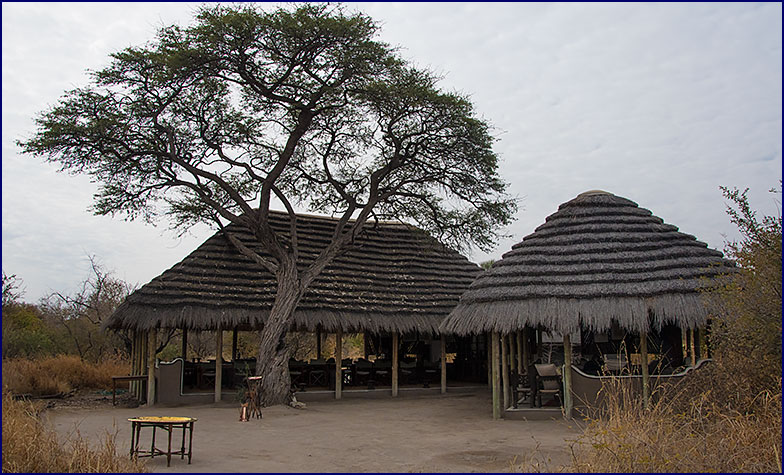
Camp Kalahari |
We arrived at the lodge at three o'clock, and were welcomed
with sandwiches and cokes. Then we were told that afternoon tea
would be served at 3:30. The lodge was lovely. There was a large
rustic, open-sided wooden building with a thatched roof, which had
a dining room on one side and a lounge area on the other.
One-bedroom tent cabins were scattered about the property,
accessed by little paths among palm trees and shrubbery. Jineen
and I shared a cabin, and Natalie, Tara and Paula shared another.
Our room was very comfortable; a spacious tent on a
permanent wooden platform, it had large twin beds, dressers and
chairs, a wooden deck, and a built in bathroom with running water
and a shower. After twelve nights camping in the bush, we didn’t
know what to do with all this luxury! There was a lizard in the
bathroom sink; this made us feel more at home. Although there was
a fence around the perimeter of the camp, we were told that the
animals came through or over the fence all the time, and there had
been fresh lion tracks in camp just the other morning. We were
instructed not to be outside after dark unless a guide escorted
us.
Jocasta took us out for a game drive at around four
o'clock. The lions were still where we had seen them when we drove
from the airstrip, dozing in the shade of a bush. The male had a
very blonde mane. They had been eating a zebra – mostly just the
hide was left. I would have preferred them to dine on wildebeest.
Jocasta was the first woman guide I have ever had in
Africa; most of the guides are men. She was friendly and
easy-going, very comfortable to be around. Her hair was French
braided in a lovely intricate pattern. We were an all girl group
now!
We saw a northern black korhaan, a
tall slender bird about the size of a chicken, with a black head,
neck and chest and mottled white and brown wings. Jocasta called
it a noisybird, though I didn’t really get why. A bit further on we saw
his mate; she was a much more subtle mottled brown color for
camouflage. At the time we thought this was a new bird for us, but
looking through my notes later, we had seen one in Savuti.
|
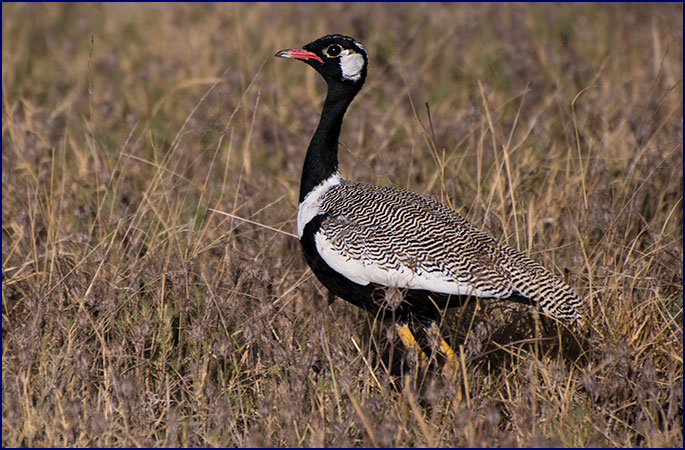
Northern black korhaan
|
Crossing the dry bushveld, we noticed shrub-like trees all
around; Jocasta identified them as zig-zag terminalia and
peppercorn terminalia. Occasional palm trees grew incongruously
out of the desert; we learned they were planted by elephants –
they eat the palm nuts, and the seeds pass through in the dung and
are replanted. We also saw many dead palm tree trunks sticking
straight up like telephone poles; the elephants shake the trees to
get the palm nuts to fall out, but sometimes the whole top of the
tree breaks off.
As we crossed a very open section
of plain, we saw half a dozen antelopes standing under a single
tall palm tree. They were springboks, which I had never seen
before. They looked similar to impala, but with white bellies, a
wide black horizontal stripe across their sides, and white faces
with short, gently curving horns. Jocasta called them the goats of
the Kalahari, but I did not think that did the beautiful animals
justice. I was really excited to see the springboks, but I wished
we were closer to them. I
was really regretting having broken my Coolpix camera with the
high-powered zoom.
|
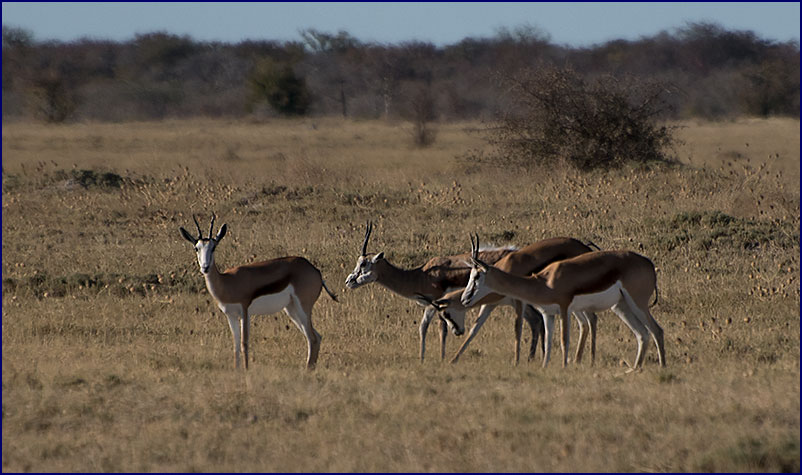
Springboks
|
We passed a wide body of water off to the right, but
Jocasta said it was salty; there was an artificial waterhole with
a borehole nearby for the animals to drink. We passed a lake where
Jocasta said the flamingoes should be, but they were nowhere in
sight. A while later, from a distance we saw a big flock of them
flying back to the lake. I hoped for a closer view later on.
A jackal hurried along across the plain. We could see an
ostrich in the distance, a round black dot on the horizon. Jocasta
made a good spot; a pair of tiny steenboks well hidden in the
underbrush. We saw a plain brown bird called an ant-eating chat, a
new one for us. We could see a huge lake ringed with palm trees in
the distance, with flamingos all around it, but it was far away. I
would have loved to get close to it, but it seemed that the
network of roads that we were allowed to drive on had limited
destinations.
|

Sandgrouse
|
We crossed an area of white powdery soil that seemed to be
a small dry soda lake, and noticed that two soccer fields were set
up on it. Beyond it we came to a mound with a pair of ground
squirrels standing up on it, like little prairie dogs. We saw a
beautiful Burchell’s sandgrouse; Jocasta told us that when they
have chicks the male will dip his chest in the water and bring the
moisture back for the babies to drink.
|
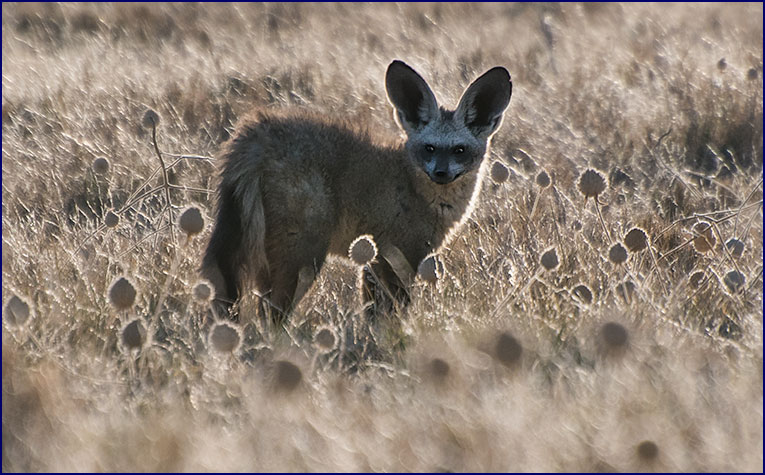
Bat-eared fox
|
Tara saw movement in the tall grass; it was a pair of
bat-eared foxes. These small foxes have thick fur, rounded backs,
black masks like a raccoon, and the most enormous ears you can
imagine - I would assume they have really good hearing. They
peered at us, backlit by the sun, and then raced off across the
golden plain. Then they paused and turned back toward us again for
a moment before scampering away out of sight. We were really lucky
to see these rare foxes - great spot, Tara!
Jocasta took us to the hyena den. A young hyena was lying
on his side in front of the den entrance; he looked up at us as we
drove up. But he was completely different from any we had seen
before; this was a brown hyena, where the others had been the
spotted type. I had never seen a brown hyena before, and was
excited to do so now. He sat up and looked at us, yawned
expansively, then flopped back down to sleep a bit more. A black-chested
snake eagle perched on a nearby tree, and then flew off across the
pan.
|
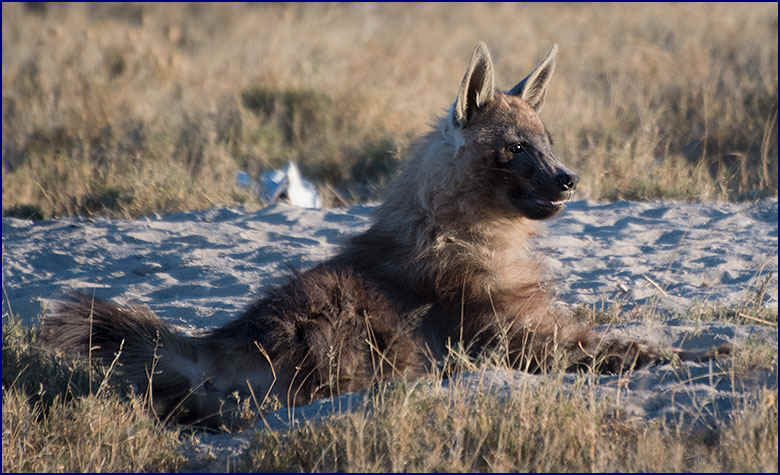
Brown hyena |
This hyena was quite unlike the spotted ones we were used
to seeing. He was dark brown in color, with much longer thicker
fur. He had a rounded back like a bear, and a face reminiscent of
a German shepherd. When he yawned, the teeth he displayed looked
small and tame compared to the spotted hyenas – he wouldn’t be
cracking any elephant bones with those.
I had read a bit about brown hyenas. They are much gentler
and less aggressive than their spotted cousins, and much rarer.
They are silent - they have no voice. Jocasta said there were
three young hyenas living here, about 10 months old. The mother
hyena feeds the babies until they are two years old, stopping by
occasionally with food. Like all hyenas, the females are the
dominant members of the clan.
We watched our boy until almost
dark. After a while he sat up and rubbed his eyes, and then stood
up and scratched his ear with his hind foot for a while – I
expect he had fleas. He made off across the plain, his back
hunched, with an odd slouchy gait. He was an interesting fellow,
but I found the spotted hyenas more appealing.
We drove out onto a salt pan and stopped for Sundowners. We
were on the edge of the Makgadikgadi Pan, which is one of the
largest salt flats in the world. It is the remnant of Lake
Makgadikgadi, which was an enormous lake that dried up several
thousand years ago. It is a completely flat featureless plain
stretching in all directions. It has a rough, crunchy greyish-white
surface formed from a mixture of soda and salt. These pans form
when rainfall collects in an area where the water cannot drain
into the ground; then the water evaporates, leaving behind traces
of salt and minerals. Over thousands of years of rain and
evaporation, these minerals accumulate on the surface, forming the
white crusty layer.
Jocasta parked in the middle of the expanse. We could just
barely make out the edge of the salt flat on the horizon. Mirages
shimmered far out on the pan, giving the illusion of water. The
surface must take its color from the sky; in the bright sun it had
looked white, but as the sun lowered it turned to a light grey,
complemented by the pastel skies. We stood side by side with our
backs to the sun, and our long, long shadows stretched across the
pan like a sunburst, coming close together at the heads. (Why do
they do that? It doesn’t make sense.)
For Sundowners, Jocasta served us some wine and snacks;
dried apples, biltong and cookies. The sun lowered from the
clouds, and the pan turned to a darker blueish grey. The brilliant
orange and rose sky was punctuated by long thin clouds lined in
fire. As the sun dropped, the horizon turned to deep pastels 360
degrees around. A perfect half-moon hung in the sky, now facing to
the right.
|
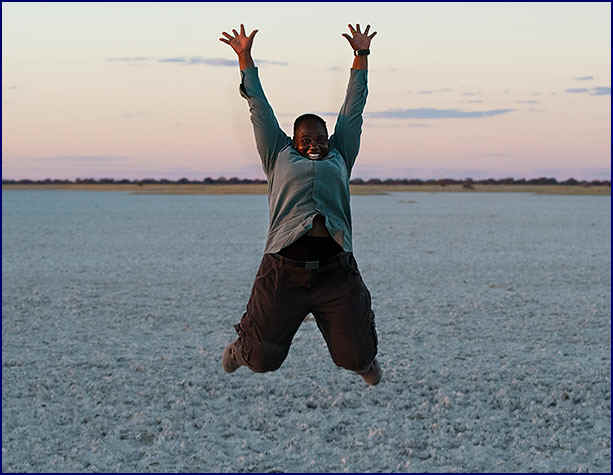
Jocasta |
Jocasta
challenged everyone to a jumping contest. She told us that if you
took a picture of people jumping on the pan, it should look like
they are floating. I took the photos while the others jumped; they
were all quite good. Jineen probably had the best style, and Tara
had the most careful preparation, working the ground to have her
footing just perfect. Natalie probably jumped the highest, despite
having a sore knee. Paula jumped impressively but did not stick
the landing. But Jocasta stole the show, enthusiastically leaping
with carefree abandon. Next Natalie, Jineen, Paula and Tara
all jumped side by side. Looking at the photos, I wouldn’t
exactly say they were floating, but it was a lot of fun
nonetheless!
We realized that we had missed the moment the sun went down
during the jumping. The sky was now painted in pink and purple all
the way around the horizon, with a deep blue crescent arcing up
opposite the sunset - Jocasta said that was called the Earth’s
Shadow.
|
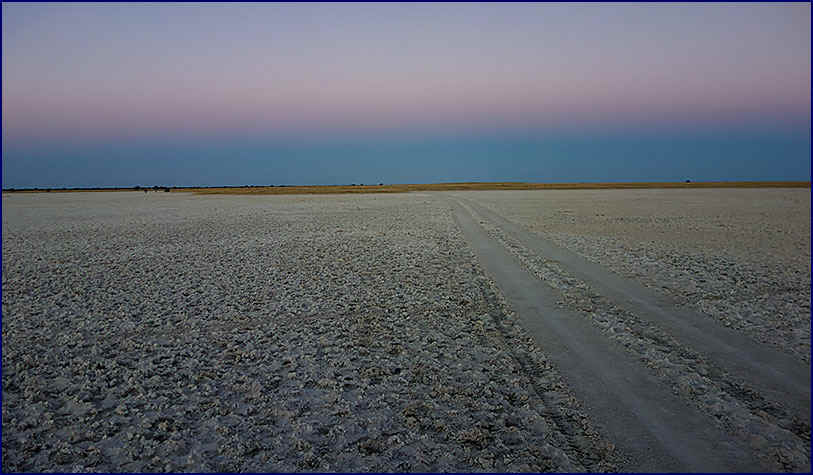
Earth's shadow
|
Darkness fell quickly, though color lingered in the sky
after sunset. We spotlighted back toward the lodge, passing many
wildebeest in the dark. We saw a cape hare and a tall fleet bird
called a double-banded courser. A black korhaan flew up suddenly,
squawking loudly; now I understood the noisybird
moniker. Zebras
crossed in front of us, their white stripes glowing in the dark.
Jocasta told us that because game is scarce, prides of lions have
smaller numbers in the Kalahari, and that is true of the hyena
clans as well.
Suddenly a call came over the radio. “We have an
aardvark!” One of the other guides had sighted an aardvark, and
was following it as it walked along beside the road. Jocasta drove
very fast, flying across the plain, bouncing over the potholes.
Would we get there in time to see it?
We did. We caught up with the
other guide, and could see the aardvark in his headlights. We
followed, getting a good look at it in the spotlight for several
minutes as it walked along, scuffling around from side to side.
Then it turned and went down a hole, disappearing from sight.
|
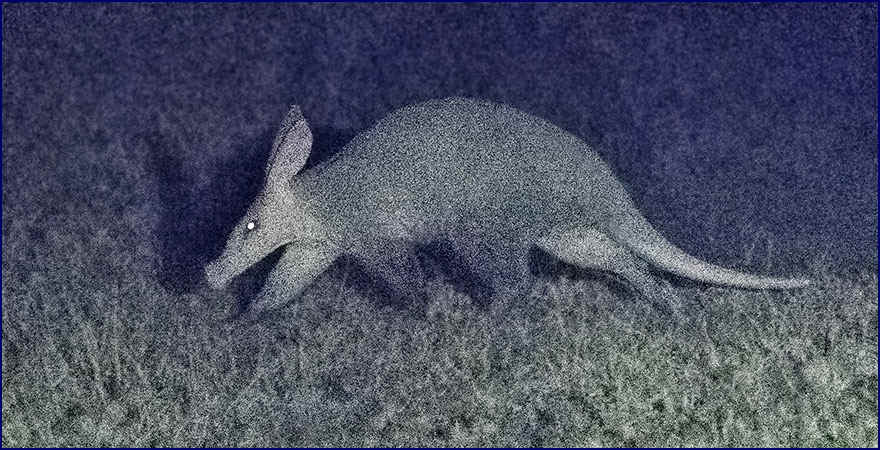
Aardvark
|
Wow! Another animal I never expected to see! The aardvark
was large, with a rounded back, huge ears and a long pig-like
snout. Of the ant-eater family, they dig large burrows, which are
often then used by other animals. Aardvarks are so unlikely
looking that I wasn’t even sure I really believed in them, much
less expected to see one. Rob would be so jealous; aardvarks had
been high on his list of things he wanted to see. In the darkness
my photos came out very grainy, but at least I had proof that
aardvarks existed.
Jocasta told us a bit about herself. She grew up on a
cattle post about twenty kilometers away, and had only been
guiding less than a year – before that she taught school for
five years, teaching children 7 to 9 years old. Jocasta did a good
job guiding, especially since she had only been doing it a short
while - however we missed Gee’s incredible depth of knowledge
and experience, from growing up in the bush as well as from years
of guiding. He had a knack for driving slowly, watching and
listening, and instinctively knowing when to stop – and so
finding the elusive or hidden things that others missed. Still, so
far the wildlife viewing at Camp Kalahari had been better than
expected; we had already seen six new species. And I still
couldn’t believe we saw an aardvark!
Back in camp, we had dinner in the big open dining area.
The food was good, but somehow it just wasn’t the same as eating
our camp-cooked meals deep in the bush. As we headed to our cabins
we were told we would find bushbabies
in our beds; we were surprised to learn they called them that - we
had thought Parker had made up that name for them.
July
31
It was very quiet here; we had
missed hearing the animal noises at night. Breakfast wasn’t
until 7:00, so we slept in. Sausage, bacon and eggs – but no
jungle oats. We went out with Jocasta on a game drive at
7:30.
There was dew on the grass, more
moisture than I expected in the desert. We stopped to look at an
aardvark borrow; we had seen many of them on the trip, but we had
a new appreciation for them now that we had actually seen an
aardvark. You could easily break an axle in one of those holes.
We passed a small waterhole surrounded with a single palm
tree, and half a dozen red-billed teal were swimming in it.
Brooding clouds and sun bathed the scene in dramatic morning
light. A rock kestrel sat on a termite mound, hunched against the
cold - another new species for us. We saw wildebeests in the
distance and a pair of ostriches close up. A kori bustard strode
across the brown plain. We got the closest look at a steenbok
we’d had yet; the diminutive deer-like antelope had one ear that
was split in two – it must have had a very narrow escape at some
point.
A long pan of blue water sparkled in the sunlight, edged in
a pink border. It was a soda lake, and as we got closer we could
see that the pink was hundreds of lesser flamingos wading along
the edges feeding – they like the salty pans and soda lakes.
|
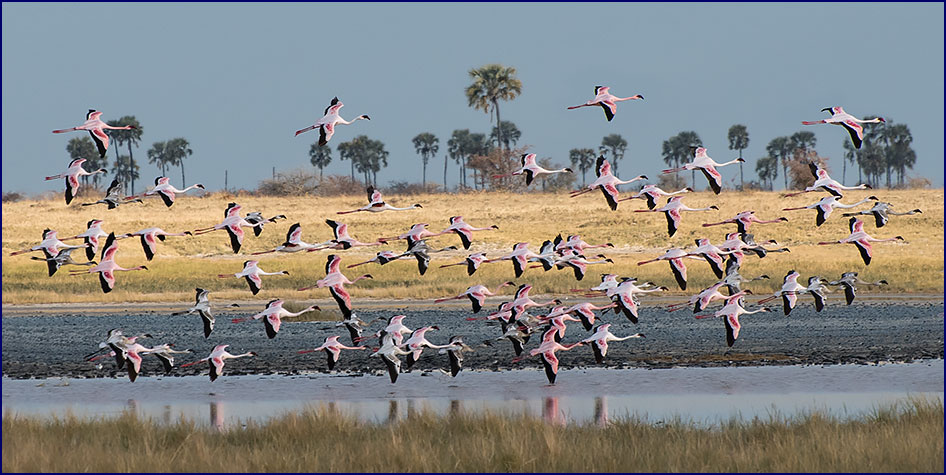
Lesser flamingos
|
Then the flamingos took flight. Hundreds of them rose and
circled the pan, flying in formation with perfect timing. They
went around three or four times, passing nearer to us overhead.
The pink flamingos against a blue sky that was scattered with soft
pink clouds made a stunning scene.
Lesser flamingos are the really pink ones, and when they
flew we could see a patch of dark rose on their wings, along with
black wingtips and a ridiculously tiny head and large hooked beak.
They were elegant and graceful. Finally the flamingos all landed,
and resumed dipping their heads in the water as they fed. Again I
wished we could get closer to them, but we had been treated to a
beautiful spectacle while they were in flight.
Then it was time for the meerkats!
There are several colonies of meerkats near Camp Kalahari
that have become habituated to humans, because of researchers
spending a lot of time observing them. Jocasta parked the vehicle
near the den; there was a man from the park service already there
waiting for us. We were joined by a French couple staying at our
lodge, who had ridden in on horses.
|
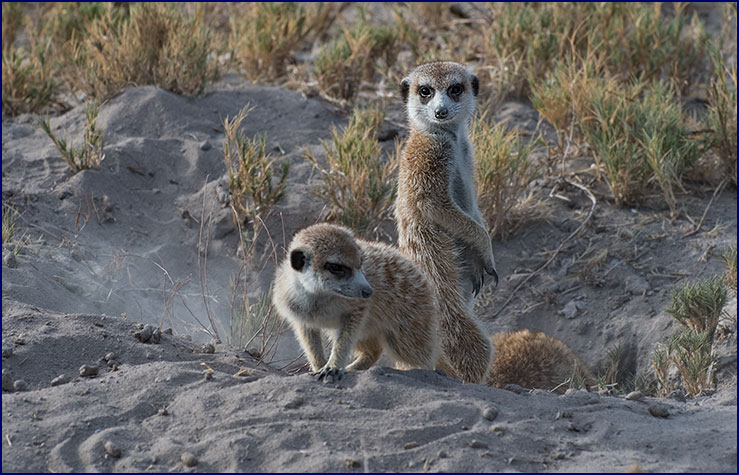
Meerkats |
We sat quietly by the warren, waiting. Before long a little
head peeked out, and then another. Then out came the meerkats,
standing upright and peering all around for enemies. As soon as
they deemed it safe and moved away from the opening, more of them
came out - soon there were about a dozen. Also known as suricates,
these relatives of the mongoose are long and slender, about the
size of a large squirrel. Their claws are sharp and strong for
digging. Their coats
are silvery-grey and fawn colored, with faint mottled stripes on
their backs. They have dark eyes, long pointy noses, tidy little
flat ears, and bright, intelligent faces.
The suricates started to scatter about and search for food,
sniffing the air, scratching and digging. They would take turns;
at all times there would be several of them standing straight up
on their hind legs acting as sentries, gazing into the distance
looking for predators while the others searched for food. We
followed the meerkats as they spread out and scurried across the
plain, stopping often to scratch and dig for insects or other
goodies. They didn’t take much notice of us, but scanned the sky
and the plains constantly for birds of prey and other enemies,
often several of them standing together facing in different
directions. Jocasta said eagles, kestrels, snakes and jackals are
among the things that would eat meerkats.
The park service man encouraged us to keep moving ahead of
the roaming meerkats and sit down in front of them; he spread
ponchos on the ground for us to sit on. Sometimes the suricates
would scamper past us, but other times they would slow down and
approach, even climbing up on someone’s legs for a better view.
Natalie had several of them crawling over her legs, and one
climbed right up into Paula’s lap. They were even cuter than I
had imagined.
|

Natalie
with the meerkats |
They got more serious about the hunt, scratching and
digging for insects, scorpions, eggs and frogs. But even so, there
were always at least two or three standing guard, peering in all
directions for danger, and then looking straight up scanning the
skies for aerial predators. It was like a scene straight out of
National Geographic. Meerkats have very sharp eyes, and can see
for several kilometers. There were 11 in this mob,
as a group of meerkats is called. One of them dug up a hibernating
frog and devoured it. There must be a lot of frogs in Africa,
judging by the number we saw get eaten by different things on this
trip.
|
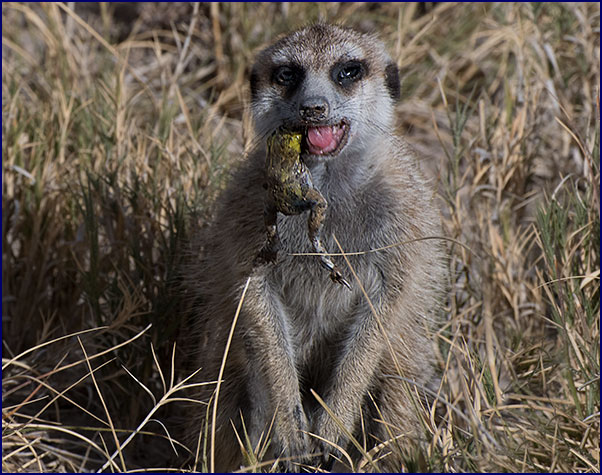
Breakfast! |
I was sitting watching several meerkats digging, when one
came and sat on my leg. I was half lying on my side, and he
climbed up onto my back for a better lookout point. Prompted by a
gesture from the park service guy, I straightened up very slowly,
and the meerkat moved up onto my shoulder. Soon I was sitting
upright with the meerkat standing on my shoulder and running his
little hands through my hair.
He sat up there quite a while, peering around from this
elevated viewpoint. It was totally cool.
I felt very privileged to have a meerkat on my shoulder.
The grooms rode up with the horses for the French couple;
they were nice thoroughbred types. We said goodbye to the meerkats
and climbed into the vehicle. On the way home we passed Jack’s
Camp; apparently Jack had started tourism in this area, and now
the same company owns 3 or 4 lodges and camps nearby, including
Camp Kalahari. They used to be hunting camps, but now they all run
wildlife safaris.
We got a little closer to the flamingoes on the way home.
The adults are pink and white, and the young ones are partially
grey. The pink color comes from a certain type of algae that they
eat; they also eat shrimp. Their necks are crazy long, often held
curled in a perfect S, and their large convex bills are pink in
color with a black tip. Those lawn ornaments just don’t do them
justice!
Jocasta was
driving along at a pretty good clip when suddenly we called out
for her to stop; there was a turtle in the road! More accurately,
we learned, it was a marsh terrapin. It was walking slowly across
the road, or at least it had been trying to until we came along.
We got out for a closer look, and for some close-up photos. It
looked a lot like a muddy rock in the road. (In fact, Paula later
discovered that she had accidentally taken a number of photos of a
muddy rock.) Another vehicle from our camp came along; the guide
said the terrapin should be hibernating this time of year. We took
a few more photos of the terrapin, and then helped him along on
his journey by putting him down on the far side of the road, in
the direction he had been going.
|
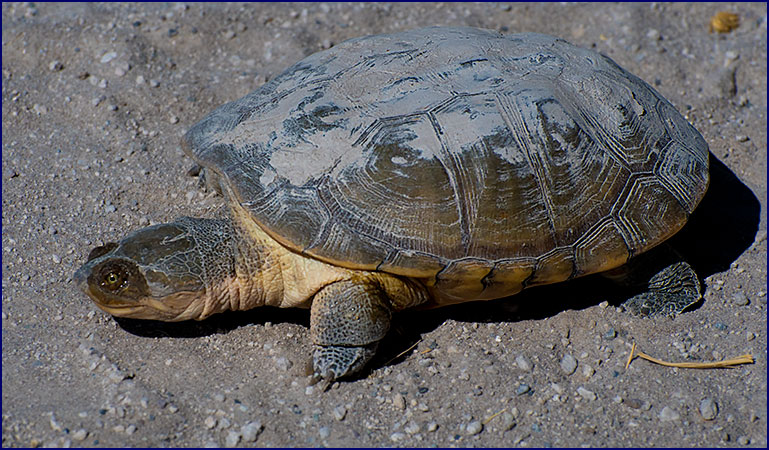
Marsh
terrapin |
We were back to the lodge by eleven o'clock. We explored
the grounds a bit, but felt that we had more free time on our
hands than we really wanted. We checked out the books in the
lounge; I started reading The
African Diaries by
Derek and Beverly Joubert. They were professional photographers
who spent a lot of time living and working in the Okavango Delta
filming for National Geographic. That’s what I want to do in my
next life!
|
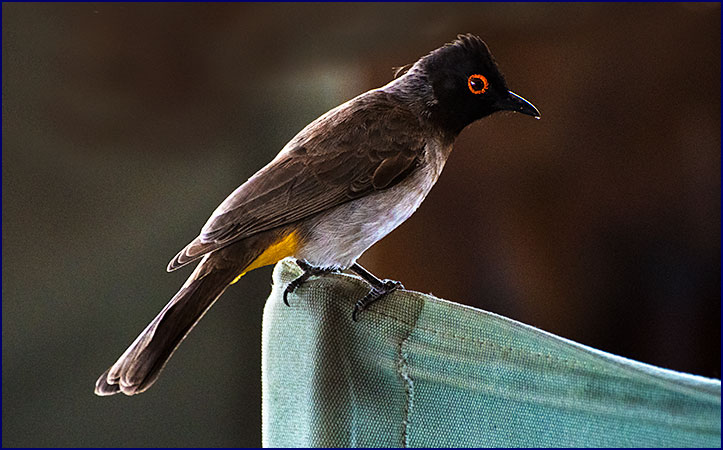
Red-eyed bulbul
|
After lunch, several red-eyed bulbuls came scavenging for
crumbs at the table; these cute little brownish-grey birds have
black heads with a small topknot, and fiery orange eyes. We saw
large black and white crows sitting in the trees nearby, they were
pied crows. Two more new species.
In
the afternoon we went on the Bushman walk. This was a unique
chance to get to interact with the San people, or Bushman tribe,
the indigenous hunter-gatherer people who were the original
inhabitants of the Kalahari Desert. There were around a dozen
adults, about equally split between men and women, with 3 or 4
small children. They came to the lodge to take us out for a nature
walk and teach us about their lifestyle. The adults were dressed
in traditional attire, clothing made from skins and hides, adorned
with beadwork and feathers. The women’s breasts were only
partially covered, and a couple of them showed signs that they
were breastfeeding a baby. Several of the children wore
polarfleece jackets, and one very young child of indeterminate sex
was wearing a frilly pink dress.
One young man, probably in his late twenties, appeared well
educated. He seemed to be in charge, and he spoke excellent
English - none of the others did, at least in our presence. The
head man introduced the tribe to us; their names, all in the San
language, consisted largely of clicks and other unduplicatable
noises, and were totally unpronounceable to us. They encouraged us
to try to say their names, and we all had a good laugh over our
pathetic attempts.
The
Bushmen took us for a walk outside the lodge fence.
In addition to our group there were half a dozen other
guests who were staying at the lodge, and we walked in single
file. I noticed that Fred had come along, riding in Paula’s
backpack with his head sticking out. Whenever one of the San
people found something of interest, a plant or root they used for
food, water or medicine, they would stop to show us. One of them
would explain what it was used for and how it was prepared,
speaking rapidly in the Bushman click language, accompanied by
very quick animated hand gestures and facial expressions. It was
fascinating to watch and listen to them. The head man interpreted
the language for us in English.
They taught us about how they lived off the land, and the
plants they used to make traditional medicines. Several of them
would be giving demos, interpreted by our head guy, while the
others looked around for things to show us. One of them dug up a
huge bulbous tuber and demonstrated how they get moisture to drink
from it. Some of the women showed us how they prepare food.
A couple of the younger men found
a scorpion, and teased it a bit. One of them picked it up and
turned it over, and showed us how it had 8 legs and 8 eyes; I am
not sure if this was true, but by that point we would have
believed anything. The head man said that sometimes kids would pit
a scorpion against a dung beetle; sounded a little cruel to me.
The men gathered some wood and dry grass, and showed us how
to make a fire. They knelt in a circle and took turns spinning a
stick against a piece of wood until it started smoking, and then
fanning the tiny flame until the dry grass ignited, and then the
wood. Soon they had a nice little blazing fire going.
Then they all sat around the fire in a circle and played a game
which involved singing, clapping in time to the music, and
demonstrating hunting techniques. It was very animated; everyone
sang or chanted, clapping and interjecting guttural clicks, while
the leading warriors were dancing, shouting, and taking turns
reenacting the hunt. I didn’t always understand exactly
what was going on, but it was amazing to watch.
The women brought out some decorations and beaded bracelets
they had made. One of them sat on the ground (in not the most
modest position) and spread the wares out on a hide. We bought
some lovely little palm nuts with animals carved into them. A
couple of the men posed comically for photos, holding the palm
nuts and brandishing their spears.
It was really special to learn about the San people, and
how they lived. We really appreciated them putting on this show
for us. We realized that the majority of the San, surely including
this group we were with, now live in towns and cities, and have
main-stream jobs. However, by coming to the lodge wearing their
traditional garb and demonstrating their tribal lifestyle, they
help to keep their history alive.
The sun was setting as we turned to head back, with great
shafts of sunlight cutting through the clouds and forming god’s
rays. Palm trees stood tall against a golden sky.
|